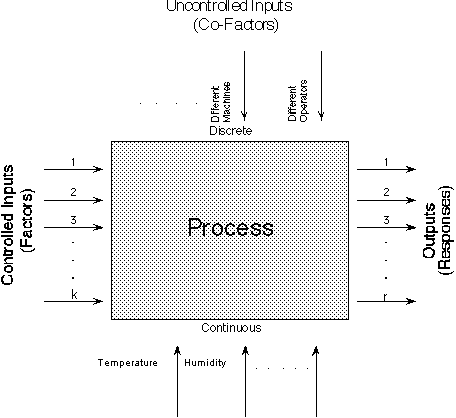5.1. Introduction
5.1.1. |
What is experimental design? |
DOE begins with determining the objectives of an experiment and selecting the process factors for the study. An Experimental Design is the laying out of a detailed experimental plan in advance of doing the experiment. Well chosen experimental designs maximize the amount of "information" that can be obtained for a given amount of experimental effort.
The statistical theory underlying DOE generally begins with the concept of process models.
Often the experiment has to account for a number of uncontrolled factors that may be discrete, such as different machines or operators, and/or continuous such as ambient temperature or humidity. Figure 1.1 illustrates this situation.

FIGURE 1.1 A `Black Box' Process Model Schematic
-
\( Y = \beta_{0} + \beta_{1}X_{1} + \beta_{2}X_{2} +
\beta_{12}X_{1}X_{2} + \mbox{experimental error} \)
For a more complicated example, a linear model with three factors X1, X2, X3 and one response, Y, would look like (if all possible terms were included in the model)
\( Y = \beta_{0} + \beta_{1}X_{1} + \beta_{2}X_{2} + \beta_{3}X_{3} + \beta_{12}X_{1}X_{2} + \\ \beta_{13}X_{1}X_{3} + \beta_{23}X_{2}X_{3} + \beta_{123}X_{1}X_{2}X_{3} + \\ \mbox{experimental error} \)The three terms with single "X's" are the main effects terms. There are k(k-1)/2 = 3*2/2 = 3 two-way interaction terms and 1 three-way interaction term (which is often omitted, for simplicity). When the experimental data are analyzed, all the unknown "\( \beta \)" parameters are estimated and the coefficients of the "X" terms are tested to see which ones are significantly different from 0.
\( \beta_{11}X_{1}^{2} + \beta_{22}X_{2}^{2} + \beta_{33}X_{3}^{2} \)Note: Clearly, a full model could include many cross-product (or interaction) terms involving squared X's. However, in general these terms are not needed and most DOE software defaults to leaving them out of the model.

